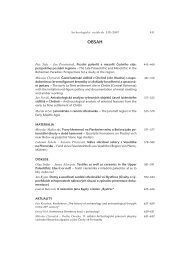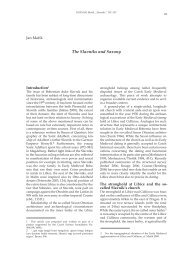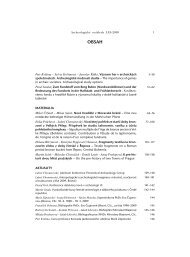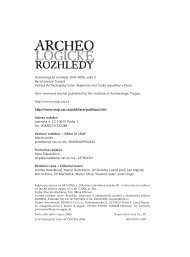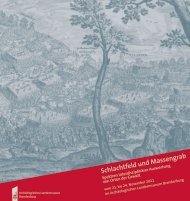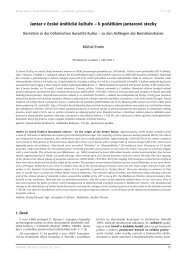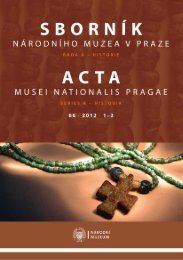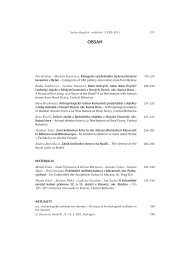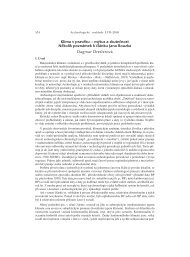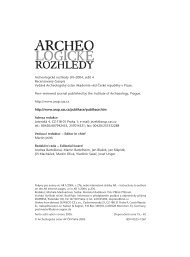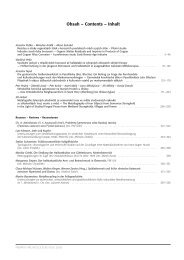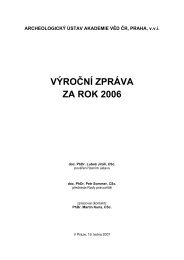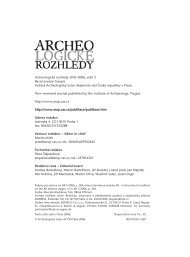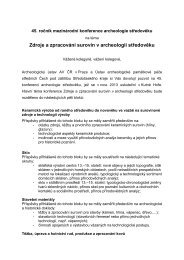Památky archeologické XCV (95) / 2004 - Archeologický ústav AV ČR
Památky archeologické XCV (95) / 2004 - Archeologický ústav AV ČR
Památky archeologické XCV (95) / 2004 - Archeologický ústav AV ČR
Create successful ePaper yourself
Turn your PDF publications into a flip-book with our unique Google optimized e-Paper software.
Ernée – Hanyk˘fi – Mary‰ka, V˘sledky pfiírodovûdn˘ch anal˘z gotick˘ch kamnov˘ch kachlÛ<br />
V˘sledky pfiírodovûdn˘ch anal˘z gotick˘ch kamnov˘ch kachlÛ<br />
z âeského Krumlova<br />
175–222<br />
Ergebnisse naturwissenschaftlicher Analysen der gotischen Ofenkacheln aus âesk˘ Krumlov<br />
Michal Ernée – Vladimír Hanyk˘fi – Martin Mary‰ka<br />
Předloženo redakci 15. 12. 2003<br />
V roce 1918 se v areálu hradu v Českém Krumlově nalezl početný soubor gotických kamnových kachlů. Dodnes se dochovalo<br />
3.868 zlomků. K poznání technologie jejich výroby a způsobů užívání slouží mimo jiné analýzy keramické hmoty. Celkem u 38 vzorků<br />
jsme provedli následující analýzy: rentgenovou difrakční analýzu, optickou mikroskopickou analýzu výbrusů, zjištění nasákavosti,<br />
objemové hmotnosti a otevřené pórovitosti, analýzu teplotní roztažnosti, chemickou analýzu a analýzu zelených glazur. Zjištěn byl<br />
vysoký podíl grafitu (až 20–30 objemových %) u největších a nejtěžších kachlů (s rozměry až 36 x 36 cm). Díky svým vlastnostem<br />
(objemová stálost při změnách teploty) byl grafit do keramické směsi přidáván záměrně – jako ostřivo. U velkých kachlů částečně<br />
nahrazoval jinak nejčastější ostřivo – křemen. Kachle s obsahem grafitu jsou odolnější při náhlých změnách teploty během výroby<br />
i při užívání. Obsah krystalických fází v použitých keramických směsích dosahoval cca 15–45 objemových %. Teplota výpalu se<br />
pohybovala v intervalu cca 800–900 °C. Zejména u kachlů s prořezávanou čelní stěnou byla na výbrusech zjištěna jednosměrně<br />
uspořádaná mikrostruktura. Podařilo se tak doložit výrobu polotovarů – hliněných plátů, na hrnčířském kruhu.<br />
jižní Čechy, Český Krumlov, kamnové kachle, pozdní gotika – 15. století, analýzy keramiky<br />
In 1918 a large collection of gothic stove tiles was found within the area of Český Krumlov Castle. 3.868 shards have survived till<br />
the present day. Analyses of the ceramic material amongst other things was employed to identify the technology of their production<br />
and manner of use. We carried out the following analyses on 38 samples altogether: x-ray difraction analysis, optical microscopic<br />
analysis of thin sections, water absorption, volume mass and open porosity, temperature expansion analysis, chemical analysis<br />
and green glaze analysis. A high proportion of graphite was established (up to 20–30 % of volume) in the case of the biggest and heaviest<br />
tiles (with dimensions of up to 36 x 36 cm). Graphite was intentionally added to the ceramic mixture as a temper due to its attributes<br />
(volume stability during changes in temperature). It was partially replaced in the case of the large tiles by the otherwise most<br />
common grog – quartz. Tiles with a graphite contact are more resistant during sudden changes in temperature during production<br />
and whilst in use. The content of the crystalline phases in the used ceramic mixture reached around 15–45 % of volume. The firing<br />
temperature fluctuated within the span of around 800–900 °C. A unilinearly arranged microstructure was established in section<br />
mainly in the case of tiles with a cut frontal wall. It was thus possible to demonstrate the production of semi-manufactures – clay<br />
slabs, on a potter’s wheel.<br />
South Bohemia, Český Krumlov, stove tiles, late gothic – 15th century, ceramic analyses<br />
PAMÁTKY ARCHEOLOGICKÉ <strong>XCV</strong>, <strong>2004</strong> 175



